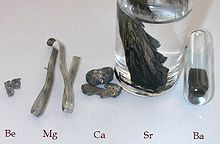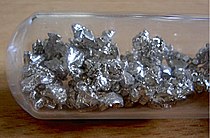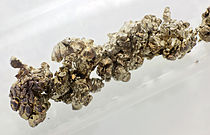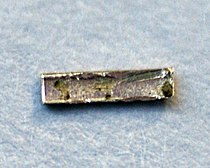Alkaline earth metal
| Alkaline earth metals | |||||||||||
|---|---|---|---|---|---|---|---|---|---|---|---|
| |||||||||||
| ↓ Period | |||||||||||
| 2 | Beryllium (Be) 4 | ||||||||||
| 3 | Magnesium (Mg) 12 | ||||||||||
| 4 | Calcium (Ca) 20 | ||||||||||
| 5 | Strontium (Sr) 38 | ||||||||||
| 6 | Barium (Ba) 56 | ||||||||||
| 7 | Radium (Ra) 88 | ||||||||||
|
Legend
| |||||||||||
The alkaline earth metals are six chemical elements in group 2 of the periodic table. They are beryllium (Be), magnesium (Mg), calcium (Ca), strontium (Sr), barium (Ba), and radium (Ra).[1] The elements have very similar properties: they are all shiny, silvery-white, somewhat reactive metals at standard temperature and pressure.[2]
Together with
All the discovered alkaline earth metals occur in nature, although radium occurs only through the decay chain of uranium and thorium and not as a primordial element.[9] There have been experiments, all unsuccessful, to try to synthesize element 120, the next potential member of the group.
Characteristics
Chemical
As with other groups, the members of this family show patterns in their
| Z | Element | No. of electrons/shell | Electron configuration[n 1] |
|---|---|---|---|
| 4 | beryllium | 2, 2 | [He] 2s2 |
| 12 | magnesium | 2, 8, 2 | [Ne] 3s2 |
| 20 | calcium | 2, 8, 8, 2 | [Ar] 4s2 |
| 38 | strontium | 2, 8, 18, 8, 2 | [Kr] 5s2 |
| 56 | barium | 2, 8, 18, 18, 8, 2 | [Xe] 6s2 |
| 88 | radium | 2, 8, 18, 32, 18, 8, 2 | [Rn] 7s2 |
Most of the chemistry has been observed only for the first five members of the group. The chemistry of radium is not well-established due to its radioactivity;[2] thus, the presentation of its properties here is limited.
The alkaline earth metals are all silver-colored and soft, and have relatively low
Beryllium is an exception: It does not react with water or steam unless at very high temperatures,[10] and its halides are covalent. If beryllium did form compounds with an ionization state of +2, it would polarize electron clouds that are near it very strongly and would cause extensive orbital overlap, since beryllium has a high charge density. All compounds that include beryllium have a covalent bond.[11] Even the compound beryllium fluoride, which is the most ionic beryllium compound, has a low melting point and a low electrical conductivity when melted.[12][13][14]
All the alkaline earth metals have two
Compounds and reactions
The alkaline earth metals all react with the
Solubility-related constants for alkaline-earth-metal fluorides Metal M2+ hydration (-MJ/mol) [15] "MF2" unit hydration (-MJ/mol)[16] MF2 lattice (-MJ/mol)[17] Solubility (mol/kL)[18] Be 2.455 3.371 3.526 soluble Mg 1.922 2.838 2.978 1.2 Ca 1.577 2.493 2.651 0.2 Sr 1.415 2.331 2.513 0.8 Ba 1.361 2.277 2.373 6
Physical and atomic
| Alkaline earth metal | Standard | Melting point (K) |
Melting point (°C) |
Boiling point (K)[4] |
Boiling point (°C)[4] |
Density (g/cm3) |
Pauling )
|
First kJ·mol−1 ) |
Covalent radius (pm)[22] |
Flame test color | |
|---|---|---|---|---|---|---|---|---|---|---|---|
| Beryllium | 9.012182(3) | 1560 | 1287 | 2744 | 2471 | 1.848 | 1.57 | 899.5 | 105 | White[23] | |
| Magnesium | 24.3050(6) | 923 | 650 | 1363 | 1090 | 1.738 | 1.31 | 737.7 | 150 | Brilliant-white[2] | |
| Calcium | 40.078(4) | 1115 | 842 | 1757 | 1484 | 1.54 | 1.00 | 589.8 | 180 | Brick-red[2] | |
| Strontium | 87.62(1) | 1050 | 777 | 1655 | 1382 | 2.64 | 0.95 | 549.5 | 200 | Crimson[2] | |
| Barium | 137.327(7) | 1000 | 727 | 2170 | 1897 | 3.62 | 0.89 | 502.9 | 215 | Apple-green[2] | |
| Radium | [226][n 3] | 969 | 696 | 2010 | 1737 | 5.5 | 0.9 | 509.3 | 221 | Crimson red[n 4] | |
Nuclear stability
Isotopes of all six alkaline earth metals are present in the Earth's crust and the solar system at varying concentrations, dependent upon the nuclides' half lives and, hence, their nuclear stabilities. The first five have one, three, five, four, and six stable (or observationally stable) isotopes respectively, for a total of 19 stable nuclides, as listed here: beryllium-9; magnesium-24, -25, -26; calcium-40, -42, -43, -44, -46; strontium-84, -86, -87, -88; barium-132, -134, -135, -136, -137, -138. The four underlined isotopes in the list are predicted by radionuclide decay energetics to be only observationally stable and to decay with extremely long half-lives through double-beta decay, though no decays attributed definitively to these isotopes have yet been observed as of 2024. Radium has no stable nor primordial isotopes.
In addition to the stable species, calcium and barium each have one extremely long-lived and
Apart from the 21 stable or nearly-stable isotopes, the six alkaline earth elements each possess a large number of known
Calcium-48 is the lightest nuclide to undergo double beta decay, as it is a nuclide with both even proton and neutron numbers and subsequently energetically forbidden to undergo single beta decays.[27] Naturally occurring calcium and barium are very weakly radioactive: calcium contains about 0.1874% calcium-48,[28] and barium contains about 0.1062% barium-130.[29] On average, one double-beta decay of calcium-48 will occur per second for every 90 tons of natural calcium, or 230 tons of limestone (calcium carbonate).[30] Through the same decay mechanism, one decay of barium-130 will occur per second for every 16,000 tons of natural barium, or 27,000 tons of baryte (barium sulfate).[31]
The longest lived isotope of radium is
Compared to their neighbors in the periodic table, alkaline earth metals tend to have a larger number of stable isotopes as they all possess an even number of protons, owing to their status as period 2 elements. Their isotopes are generally more stable due to nucleon pairing. This stability is further enhanced if the isotope also has an even number of neutrons, as both kinds of nucleons can then participate in pairing and contribute to nuclei stability.
History
Etymology
The alkaline earth metals are named after their
Discovery
The calcium compounds calcite and lime have been known and used since prehistoric times.[34] The same is true for the beryllium compounds beryl and emerald.[35] The other compounds of the alkaline earth metals were discovered starting in the early 15th century. The magnesium compound magnesium sulfate was first discovered in 1618 by a farmer at Epsom in England. Strontium carbonate was discovered in minerals in the Scottish village of Strontian in 1790. The last element is the least abundant: radioactive radium, which was extracted from uraninite in 1898.[36][37][38]
All elements except beryllium were isolated by electrolysis of molten compounds. Magnesium, calcium, and strontium were first produced by Humphry Davy in 1808, whereas beryllium was independently isolated by Friedrich Wöhler and Antoine Bussy in 1828 by reacting beryllium compounds with potassium. In 1910, radium was isolated as a pure metal by Curie and André-Louis Debierne also by electrolysis.[36][37][38]
Beryllium

Magnesium
Magnesium was first produced by Humphry Davy in England in 1808 using electrolysis of a mixture of magnesia and mercuric oxide.[44] Antoine Bussy prepared it in coherent form in 1831. Davy's first suggestion for a name was magnium,[44] but the name magnesium is now used.
Calcium
Strontium
In 1790, physician
Barium

Radium
While studying
Occurrence

Beryllium occurs in the Earth's crust at a concentration of two to six
Magnesium and calcium are very common in the Earth's crust, being respectively the fifth- and eighth-most-abundant elements. None of the alkaline earth metals are found in their elemental state. Common magnesium-containing minerals are carnallite, magnesite, and dolomite. Common calcium-containing minerals are chalk, limestone, gypsum, and anhydrite.[2]
Strontium is the fifteenth-most-abundant element in the Earth's crust. The principal minerals are
Radium, being a decay product of uranium, is found in all uranium-bearing ores.[60] Due to its relatively short half-life,[61] radium from the Earth's early history has decayed, and present-day samples have all come from the much slower decay of uranium.[60]
Production
This section needs expansion. You can help by adding to it. (November 2012) |

Most beryllium is extracted from beryllium hydroxide. One production method is sintering, done by mixing beryl, sodium fluorosilicate, and soda at high temperatures to form sodium fluoroberyllate, aluminum oxide, and silicon dioxide. A solution of sodium fluoroberyllate and sodium hydroxide in water is then used to form beryllium hydroxide by precipitation. Alternatively, in the melt method, powdered beryl is heated to high temperature, cooled with water, then heated again slightly in sulfuric acid, eventually yielding beryllium hydroxide. The beryllium hydroxide from either method then produces beryllium fluoride and beryllium chloride through a somewhat long process. Electrolysis or heating of these compounds can then produce beryllium.[11]
In general, strontium carbonate is extracted from the mineral
To produce barium, barite (impure barium sulfate) is converted to
Applications
Beryllium is used mainly in military applications,
Magnesium has many uses. It offers advantages over other structural materials such as aluminum, but magnesium's usage is hindered by its flammability.[69] Magnesium is often alloyed with aluminum, zinc and manganese to increase its strength and corrosion resistance.[70] Magnesium has many other industrial applications, such as its role in the production of iron and steel,[further explanation needed] and in the Kroll process for production of titanium.[71]
Calcium is used as a reducing agent in the separation of other metals such as uranium from ore. It is a major component of many alloys, especially aluminum and copper alloys, and is also used to deoxidize alloys. Calcium has roles in the making of cheese, mortars, and cement.[72]
Strontium and barium have fewer applications than the lighter alkaline earth metals.
Radium has many former applications based on its radioactivity, but its use is no longer common because of the adverse health effects and long half-life. Radium was frequently used in
Representative reactions of alkaline earth metals
Reaction with halogens
- Ca + Cl2 → CaCl2
Anhydrous calcium chloride is a
Reaction with oxygen
- Ca + 1/2O2 → CaO
- Mg + 1/2O2 → MgO
Reaction with sulfur
- Ca + 1/8S8 → CaS
Reaction with carbon
With carbon, they form acetylides directly. Beryllium forms carbide.
- 2Be + C → Be2C
- CaO + 3C → CaC2 + CO (at 2500 °C in furnace)
- CaC2 + 2H2O → Ca(OH)2 + C2H2
- Mg2C3 + 4H2O → 2Mg(OH)2 + C3H4
Reaction with nitrogen
Only Be and Mg form nitrides directly.
- 3Be + N2 → Be3N2
- 3Mg + N2 → Mg3N2
Reaction with hydrogen
Alkaline earth metals react with hydrogen to generate saline hydride that are unstable in water.
- Ca + H2 → CaH2
Reaction with water
Ca Sr and Ba readily react with water to form hydroxide and hydrogen gas. Be and Mg are passivated by an impervious layer of oxide. However, amalgamated magnesium will react with water vapor.
- Mg + H2O → MgO + H2
Reaction with acidic oxides
Alkaline earth metals reduce the nonmetal from its oxide.
- 2Mg + SiO2 → 2MgO + Si
- 2Mg + CO2 → 2MgO + C (in solid carbon dioxide)
Reaction with acids
- Mg + 2HCl → MgCl2 + H2
- Be + 2HCl → BeCl2 + H2
Reaction with bases
Be exhibits amphoteric properties. It dissolves in concentrated sodium hydroxide.
- Be + NaOH + 2H2O → Na[Be(OH)3] + H2
Reaction with alkyl halides
Magnesium reacts with alkyl halides via an
- RX + Mg → RMgX (in anhydrous ether)
Identification of alkaline earth cations
The flame test
The table below[83] presents the colors observed when the flame of a Bunsen burner is exposed to salts of alkaline earth metals. Be and Mg do not impart colour to the flame due to their small size.[84]
| Metal | Colour |
|---|---|
| Ca | Brick-red |
| Sr | Crimson red |
| Ba | Green/Yellow |
| Ra | Carmine red |
In solution
Mg2+
Disodium phosphate is a very selective reagent for magnesium ions and, in the presence of ammonium salts and ammonia, forms a white precipitate of ammonium magnesium phosphate.
- Mg2+ + NH3 + Na2HPO4 → (NH4)MgPO4 + 2Na+
Ca2+
Ca2+ forms a white precipitate with ammonium oxalate. Calcium oxalate is insoluble in water, but is soluble in mineral acids.
- Ca2+ + (COO)2(NH4)2 → (COO)2Ca + NH4+
Sr2+
Strontium ions precipitate with soluble sulfate salts.
- Sr2+ + Na2SO4 → SrSO4 + 2Na+
All ions of alkaline earth metals form white precipitate with ammonium carbonate in the presence of ammonium chloride and ammonia.
Compounds of alkaline earth metals
Oxides
The alkaline earth metal oxides are formed from the thermal decomposition of the corresponding
- CaCO3 → CaO + CO2 (at approx. 900°C)
In laboratory, they are obtained from hydroxides:
- Mg(OH)2 → MgO + H2O
or nitrates:
- Ca(NO3)2 → CaO + 2NO2 + 1/2O2
The oxides exhibit basic character: they turn phenolphthalein red and litmus, blue. They react with water to form hydroxides in an exothermic reaction.
- CaO + H2O → Ca(OH)2 + Q
Calcium oxide reacts with carbon to form acetylide.
- CaO + 3C → CaC2 + CO (at 2500°C)
- CaC2 + N2 → CaCN2 + C
- CaCN2 + H2SO4 → CaSO4 + H2N—CN
- H2N—CN + H2O → (H2N)2CO (urea)
- CaCN2 + 2H2O → CaCO3 + NH3
Hydroxides
They are generated from the corresponding oxides on reaction with water. They exhibit basic character: they turn phenolphthalein pink and litmus, blue. Beryllium hydroxide is an exception as it exhibits amphoteric character.
- Be(OH)2 + 2HCl → BeCl2 + 2 H2O
- Be(OH)2 + NaOH → Na[Be(OH)3]
Salts
Ca and Mg are found in nature in many compounds such as
- Na2O·Al2O3·6SiO2 + Ca2+ → CaO·Al2O3·6SiO2 + 2Na+
Biological role and precautions
This section needs expansion. You can help by adding to it. (January 2013) |
Magnesium and calcium are ubiquitous and essential to all known living organisms. They are involved in more than one role, with, for example, magnesium or calcium
Strontium plays an important role in marine aquatic life, especially hard corals, which use strontium to build their
Beryllium and radium, however, are toxic. Beryllium's low aqueous solubility means it is rarely available to biological systems; it has no known role in living organisms and, when encountered by them, is usually highly toxic.[11] Radium has a low availability and is highly radioactive, making it toxic to life.
Extensions
The next alkaline earth metal after radium is thought to be
The chemistry of element 120 is predicted to be closer to that of
The next alkaline earth metal after element 120 has not been definitely predicted. Although a simple extrapolation using the Aufbau principle would suggest that element 170 is a congener of 120, relativistic effects may render such an extrapolation invalid. The next element with properties similar to the alkaline earth metals has been predicted to be element 166, though due to overlapping orbitals and lower energy gap below the 9s subshell, element 166 may instead be placed in group 12, below copernicium.[89][90]
See also
Explanatory notes
- Noble gas notationis used for conciseness; the nearest noble gas that precedes the element in question is written first, and then the electron configuration is continued from that point forward.
- least significant figure(s) of the number prior to the parenthesized value (i.e., counting from rightmost digit to left). For instance, 1.00794(7) stands for 1.00794±0.00007, whereas 1.00794(72) stands for 1.00794±0.00072.[19]
- ^ The element does not have any stable nuclides, and a value in brackets indicates the mass number of the longest-lived isotope of the element.[20][21]
- ^ The color of the flame test of pure radium has never been observed; the crimson-red color is an extrapolation from the flame test color of its compounds.[24]
References
- ISBN 0-85404-438-8. pp. 51. Electronic version..
- ^ a b c d e f g h i j Royal Society of Chemistry. "Visual Elements: Group 2–The Alkaline Earth Metals". Visual Elements. Royal Society of Chemistry. Archived from the original on 5 October 2011. Retrieved 13 January 2012.
- ^ "Periodic Table: Atomic Properties of the Elements" (PDF). nist.gov. National Institute of Standards and Technology. September 2010. Archived (PDF) from the original on 2012-08-09. Retrieved 17 February 2012.
- ^ a b c d e f g Lide, D. R., ed. (2003). CRC Handbook of Chemistry and Physics (84th ed.). Boca Raton, FL: CRC Press.
- ISBN 978-0-08-037941-8.
- .
- ^ Bent Weberg, Libby (18 January 2019). ""The" periodic table". Chemical & Engineering News. 97 (3). Archived from the original on 1 February 2020. Retrieved 27 March 2020.
- PMID 23609097.
- ^ "Abundance in Earth's Crust". WebElements.com. Archived from the original on 9 March 2007. Retrieved 14 April 2007.
- ^ Clark, Jim (December 2021). "Reactions of the Group 2 elements with water". Retrieved 2012-08-14.
'Beryllium has no reaction with water or steam even at red heat.' This was commonly quoted in textbooks....However, a researcher...sent me a photo showing the result of exposing beryllium to steam at 800°C. It definitely reacts. I think the problem is that beryllium is both expensive and carries major health risks....Textbook (or these days, web) statements about it never get checked.
- ^ a b c Jakubke, Hans-Dieter; Jeschkeit, Hans, eds. (1994). Concise Encyclopedia Chemistry. trans. rev. Eagleson, Mary. Berlin: Walter de Gruyter.
- ISBN 978-0-12-023614-5.
- ISBN 978-0-87170-721-5.
- ISBN 978-0-8031-0942-1.
- ^ Wiberg, Wiberg & Holleman 2001, pp. XXXVI–XXXVII.
- ^ Wiberg, Wiberg & Holleman 2001, p. XXXVI.
- ^ Lide 2004, p. 12-23.
- ^ Wiberg, Wiberg & Holleman 2001, p. 1073.
- CODATA reference. National Institute of Standards and Technology. Archivedfrom the original on 16 October 2011. Retrieved 26 September 2011.
- ^ (PDF) from the original on 2 November 2012. Retrieved 7 February 2012.
- ^ (PDF) from the original on 11 February 2012. Retrieved 11 February 2012.
- .
- doi:10.1021/ed080p952. Archived from the original(PDF) on 2010-06-11. Retrieved 2012-05-06.
- ^ Kirby, H. W; Salutsky, Murrell L (1964). The Radiochemistry of Radium. National Academies Press.[permanent dead link]
- ^ "Uranium-235 and Uranium-238 | Hazardous Waste Cleanup Levels | Washington University in St. Louis". sites.wustl.edu. Retrieved 2024-01-18.
- ^ "Nuclear Data for Safeguards". www-nds.iaea.org. Retrieved 2024-01-18.
- ^ Richard B. Firestone (15 March 2010). "Isotopes of Calcium (Z=20)". Lawrence Berkeley National Laboratory. Archived from the original on 6 May 2012. Retrieved 12 June 2012.
- ^ Richard B. Firestone (15 March 2010). "Isotopes of Barium (Z=56)". Lawrence Berkeley National Laboratory. Archived from the original on 6 May 2012. Retrieved 12 June 2012.
- ^ "1/(1.87e-3*1000/40.078*6.02e 23*ln2*1/(5.6e 19y/s))*1e-3*100.0869/40.078 - Wolfram|Alpha". www.wolframalpha.com. Retrieved 2024-01-18.
- ^ "1/(1.06e-3*1000/137.327*6.02e 23*ln2*1/(1.6e 21y/s))*1e-3*233.38/137.327 - Wolfram|Alpha". www.wolframalpha.com. Retrieved 2024-01-18.
- ^ "Lecture 7: Basics of SF Stellar Nucleosynthesis" (PDF). www2.mpia-hd.mpg.de.
- ISBN 0-313-33438-2.
- ^ a b Miller, M. Michael. "Commodity report:Lime" (PDF). United States Geological Survey. Archived (PDF) from the original on 2011-11-12. Retrieved 2012-03-06.
- ^ a b Weeks 1968, p. 535.
- ^ .
- ^ .
- ^ doi:10.1021/ed010p79.
- ^ Weeks 1968, p. 537.
- ^ Vauquelin, Louis-Nicolas (1798). "De l'Aiguemarine, ou Béril; et découverie d'une terre nouvelle dans cette pierre". Annales de Chimie (26): 155–169. Archived from the original on 2016-04-27.
- .
- ^ Bussy, Antoine (1828). "D'une travail qu'il a entrepris sur le glucinium". Journal de Chimie Médicale (4): 456–457. Archived from the original on 2016-05-22.
- ^ a b Weeks 1968, p. 539.
- ^ from the original on 2015-09-30.
- ]
- ISBN 978-3-527-61201-7.
- from the original on 2015-09-30.
- S2CID 20396691.
- ^ Davy, Humphry (1808). researches on the decomposition of the earths; with observations on the metals obtained from the alkaline earths, and on the amalgam procured from ammonia. Vol. 98. Philosophical Transactions of the Royal Society of London. pp. 333–370. Archived from the original on 2015-09-30.
- .
- .
- ^ Curie, Pierre; Curie, Marie; Bémont, Gustave (1898). "Sur une nouvelle substance fortement radio-active, contenue dans la pechblende (On a new, strongly radioactive substance contained in pitchblende)". Comptes Rendus. 127: 1215–1217. Archived from the original on 2009-08-06. Retrieved 2009-08-01.
- ^ "radium". Online Etymology Dictionary. Archived from the original on 13 January 2012. Retrieved 20 August 2011.
- ISBN 0-911910-00-X.
- ISBN 0-19-850340-7.
- The University of Sheffield and WebElements Ltd, UK. WebElements. Archived from the originalon 5 August 2011. Retrieved 6 August 2011.
- The University of Sheffield and WebElements Ltd, UK. WebElements. Archived from the originalon 4 August 2011. Retrieved 6 August 2011.
- ^ Ober, Joyce A. "Mineral Commodity Summaries 2010: Strontium" (PDF). United States Geological Survey. Archived (PDF) from the original on 2010-07-16. Retrieved 2010-05-14.
- ^ ISBN 978-3527306732.
- ^ a b "Radium" Archived 2012-11-15 at the Wayback Machine, Los Alamos National Laboratory. Retrieved on 2009-08-05.
- ISBN 978-0-19-983178-4. Archivedfrom the original on 2015-09-05.
- ISBN 9789054108290. Archivedfrom the original on 2016-04-27.
- ^ Miller, M. M. "Barite" (PDF). USGS.gov. Archived (PDF) from the original on 2012-07-07.
- S2CID 262306041.
- ISBN 3-540-66693-1.
- ^ "Purdue engineers create safer, more efficient nuclear fuel, model its performance". Purdue University. 27 September 2005. Archived from the original on 27 May 2012. Retrieved 18 September 2008.
- ISBN 978-0-87170-654-6.
- ISBN 1-56676-661-3.
- ^ ISBN 978-1-57912-814-2. [dead link]
- ISBN 0-87170-657-1.
- ISBN 3527306730.
- ISBN 0-8493-0486-5.
- hdl:10261/185836.
- S2CID 11109902.
- S2CID 2907823.
- ^ Standring, WJF; Selnæs, ØG; Sneve, M; Finne, IE; Hosseini, A; Amundsen, I; Strand, P (2005), Assessment of environmental, health and safety consequences of decommissioning radioisotope thermal generators (RTGs) in Northwest Russia (PDF), Østerås: Norwegian Radiation Protection Authority, archived from the original (PDF) on 2016-03-03, retrieved 2019-03-13
- ^ "Power Sources for Remote Arctic Applications" (PDF). Washington, DC: U.S. Congress, Office of Technology Assessment. June 1994. OTA-BP-ETI-129. Archived (PDF) from the original on 2022-10-09.
- ISBN 978-0-85404-596-9.
- PMID 13134440.)
{{cite journal}}: CS1 maint: numeric names: authors list (link - ^ "Mass Media & Environmental Conflict – Radium Girls". Archived from the original on 2009-07-21. Retrieved 2009-08-01.
- ISBN 978-0-309-11014-3. Archivedfrom the original on 2015-09-05.
- ISBN 978-0-07-005115-7. Archivedfrom the original on 2015-09-05.
- ^ "QUALITATIVE ANALYSIS TESTS for metal cations identifying positive ions, carbonates, ammonium ion, hydrogen ions, acids identification". www.docbrown.info.
- ^ "Beryllium and magnesium do not give colour to flame whereas other alkaline earth metals do so. Why?". www.askiitians.com.
- ^ Gäggeler, Heinz W. (5–7 November 2007). "Gas Phase Chemistry of Superheavy Elements" (PDF). Lecture Course Texas A&M. Archived from the original (PDF) on 20 February 2012. Retrieved 26 February 2012.
- .
- ^ "Home / FIAS". fias.institute. Retrieved 2024-02-11.
- ^ a b Seaborg, G. T. (c. 2006). "transuranium element (chemical element)". Encyclopædia Britannica. Archived from the original on 30 November 2010. Retrieved 16 March 2010.
- S2CID 117157377.
- ISBN 978-1-4020-3555-5.
Bibliography
- Lide, David R. (2004). Handbook of Chemistry and Physics (84th ed.). CRC Press. ISBN 978-0-8493-0566-5.
- Weeks, Mary Elvira; Leichester, Henry M. (1968). Discovery of the Elements. Easton, PA: Journal of Chemical Education. LCCCN 68-15217.
- Wiberg, Egon; Wiberg, Nils; Holleman, Arnold Frederick (2001). Inorganic chemistry. Academic Press. ISBN 978-0-12-352651-9. Retrieved 3 March 2011.
Further reading
- Group 2 – Alkaline Earth Metals, Royal Chemistry Society.
- Hogan, C. Michael. 2010. "Calcium". A. Jorgensen, C. Cleveland, eds. Encyclopedia of Earth. National Council for Science and the Environment.
- Maguire, Michael E. "Alkaline Earth Metals". Chemistry: Foundations and Applications. Ed. J. J. Lagowski. Vol. 1. New York: Macmillan Reference USA, 2004. 33–34. 4 vols. Gale Virtual Reference Library. Thomson Gale.
- Petrucci R.H., Harwood W.S., and Herring F.G., General Chemistry (8th edition, Prentice-Hall, 2002)
- Silberberg, M.S., Chemistry: The Molecular Nature of Matter and Change (3rd edition, McGraw-Hill, 2009)






